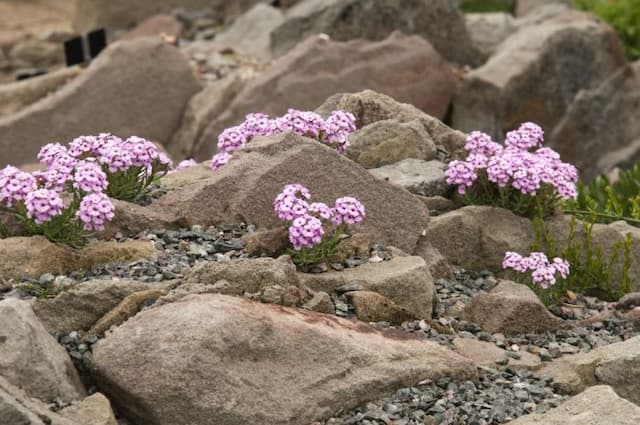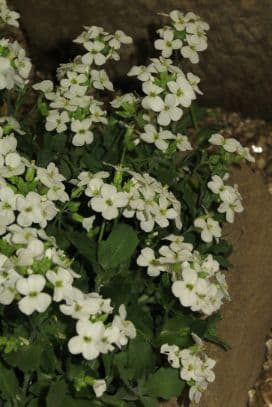Variegated Rock Cress Arabis procurrens 'Variegata' (v)

ABOUT
Arabis procurrens 'Variegata', commonly known as Variegated Wall Cress, is an attractive perennial with a striking appearance due to its variegated foliage. The leaves of this plant exhibit a creamy white to pale yellow edging, creating a distinctive contrast against the green center. This variegation adds a splash of brightness to the foliage, making it stand out in garden settings. The leaves themselves are small and oval-shaped, often forming a dense, ground-hugging rosette. As the seasons change, the Variegated Wall Cress produces delicate white flowers that rise slightly above the foliage on slender stems. These blossoms are usually clustered together in tight bunches, providing a soft, frothy appearance that enhances the plant's decorative appeal. Overall, the combination of the variegated leaves and the white flowers gives the Variegated Wall Cress a lively, yet elegant look, making it a popular choice for rock gardens, borders, and as a colorful ground cover. Its visual texture and coloration can be a valuable addition to any garden looking for foliage with a touch of variegation.
About this plant
 Names
NamesFamily
Brassicaceae
Synonyms
Variegated Wall Cress, Variegated Rock Cress
Common names
Arabis procurrens 'Variegata'.
 Toxicity
ToxicityTo humans
The variegated wall cress is not commonly known for being toxic to humans. However, as with many plants, it is always prudent to avoid ingestion and to keep them out of reach of children, as individual sensitivities can vary, and some people might experience gastrointestinal upset or allergic reactions upon ingesting or handling unfamiliar plants.
To pets
The variegated wall cress is not listed as toxic to pets. However, pets sometimes have unexpected reactions to plants, and it's always a good idea to keep an eye on your pet and consult with a veterinarian if they have ingested any part of a plant and are showing signs of distress. Typical signs of plant poisoning in pets might include vomiting, diarrhea, drooling, or difficulty breathing.
 Characteristics
CharacteristicsLife cycle
Perennials
Foliage type
Evergreen
Color of leaves
Variegated
Flower color
White
Height
0.5 feet (15 cm)
Spread
1 foot (30 cm)
Plant type
Herb
Hardiness zones
4
Native area
Europe
Benefits
 General Benefits
General Benefits- Attractive Foliage: Arabis procurrens 'Variegata' features variegated leaves that add visual interest to garden spaces throughout the growing season.
- Groundcover: It serves as an effective groundcover, spreading to cover bare spots and suppress weeds.
- Drought Tolerance: Once established, it's quite drought-tolerant, making it suitable for xeriscaping and low-water gardens.
- Easy to Grow: This plant is known for being easy to cultivate, requiring minimal maintenance, which is ideal for novice gardeners.
- Edging Plant: Its compact growth habit makes it a good choice for edging paths and garden beds.
- Rapid Growth: It grows relatively quickly, providing fast coverage and satisfying immediate landscaping needs.
- Attracts Pollinators: This plant can attract bees and other pollinators to the garden, which is beneficial for the local ecosystem.
- Cold Hardy: It is tolerant of cold temperatures and can survive in cooler climates.
- Long Blooming Period: The plant offers a relatively long season of blooms, which can help sustain visual garden interest.
- Soil Stabilization: Its root system helps to stabilize soil and prevent erosion on slopes and banks.
 Medical Properties
Medical PropertiesThis plant is not used for medical purposes.
 Air-purifying Qualities
Air-purifying QualitiesThis plant is not specifically known for air purifying qualities.
 Other Uses
Other Uses- The Variegated Wall Cress can be used in rock gardens for its low-growing, mat-forming characteristics, providing a textured ground cover that highlights the features of other plants.
- In fairy gardens, the intricate leaves and subtle variegation of Variegated Wall Cress provide a miniature landscape ideal for imaginative garden designs.
- This plant may be utilized in between paving stones or stepping stones where its hardy nature allows it to thrive even in compacted soil.
- The contrasting white and green foliage of Variegated Wall Cress can accentuate darker foliage plants, providing a visual break in garden arrangements.
- Variegated Wall Cress can be incorporated in green roofing projects for its drought resistance and ability to form insulative mats.
- This plant's ability to resist erosion makes it suitable for planting on slopes or banks to stabilize the soil and prevent runoff.
- As a border plant, Variegated Wall Cress creates a neat edge to garden paths or flower beds, with its low height and spreading habit.
- Butterfly and bee garden designs can include Variegated Wall Cress since it can attract pollinators when in bloom with its clusters of white flowers.
- In container gardens, Variegated Wall Cress can be grown to cascade over the edges of pots, adding a dynamic element to the planting scheme.
- The plant can be used in artistic garden patterns or mosaics due to its gradual spreading habit and the textured, colorful foliage that can define different garden compartments or designs.
Interesting Facts
 Feng Shui
Feng ShuiThe plant Arabis (commonly known as Rock Cress) is not used in Feng Shui practice.
 Zodiac Sign Compitability
Zodiac Sign CompitabilityThe plant Arabis (commonly known as Rock Cress) is not used in astrology practice.
 Plant Symbolism
Plant Symbolism- Purity: The Arabis procurrens, commonly known as Variegated rock cress, often bears white flowers, which are traditionally associated with purity and cleanliness.
- Innocence: White flowers, such as those of the Variegated rock cress, can symbolize innocence and simplicity.
- Resilience: Rock cress is known for its ability to grow in rocky, challenging conditions, symbolizing resilience and persistence in the face of adversity.
- Protection: Because rock cress often grows in a mat-forming habit, covering the ground where it propagates, it can symbolize a natural protection of the areas it covers.
 Water
WaterThe Variegated Wall Cress (Arabis procurrens 'Variegata') should be watered thoroughly, allowing the water to reach deep into the root zone, and then allowed to dry out slightly before the next watering. This usually means watering the plant approximately once a week, but this can vary depending on climate and weather conditions. Aim to provide about one gallon of water per square yard every week during the growing season. In hot, dry conditions, you might need to water more frequently, while in cooler, wet periods, less water may be required. Adjust the watering schedule to ensure the soil is moist but not waterlogged, as this plant dislikes standing in water.
 Light
LightThe Variegated Wall Cress prefers full sun to partial shade. It will thrive best in a location where it receives at least four hours of direct sunlight daily, so a sunny border or rock garden is ideal. Be mindful that too much harsh afternoon sun in extremely hot climates may scorch the leaves, so in such cases, providing some afternoon shade is beneficial.
 Temperature
TemperatureVariegated Wall Cress is hardy and can tolerate a wide range of temperatures, surviving in conditions as low as 0°F. The ideal growing temperature for this plant is between 60°F and 75°F, where it can flourish and produce its best foliage and flowers. It can tolerate summer heat as long as the roots are kept cool with mulch and adequate moisture.
 Pruning
PruningPrune the Variegated Wall Cress to remove any dead or damaged foliage and to shape the plant as needed, usually after the main flowering period in late spring or early summer. Pruning encourages new growth and a denser habit, leading to more blooms in the following season. It can be cut back by about a third after flowering to maintain a compact form.
 Cleaning
CleaningAs needed
 Soil
SoilThe best soil mix for the variegated wall cress (Arabis procurrens 'Variegata') should be well-draining and loamy with an addition of organic matter such as compost or peat moss. A pH between 6.0 to 7.5 is ideal for this plant.
 Repotting
RepottingVariegated wall cress rarely needs repotting as it's typically grown as a perennial ground cover outdoors. Only repot container-grown specimens if they outgrow their pot, which may be every few years.
 Humidity & Misting
Humidity & MistingVariegated wall cress tolerates a wide range of humidity levels typical of outdoor environments and does not require specific humidity conditions when grown outdoors.
 Suitable locations
Suitable locationsIndoor
Ensure bright light, well-draining soil, and infrequent watering.
Outdoor
Plant in well-drained soil, full sun or partial shade, and water regularly.
Hardiness zone
4-9 USDA
 Life cycle
Life cycleArabis procurrens 'Variegata', commonly known as Variegated Wall Cress, begins its life cycle when the seeds germinate in cool to temperate climates, usually in spring. The seedlings develop into a basal rosette of green and white variegated leaves close to the ground. As the plant matures, it develops stems that bear small, clustered white flowers, typically blooming in early to mid-spring. After pollination, typically by insects, the flowers develop into elongated seed pods called siliques. Once these pods mature, they release seeds that can germinate to start a new life cycle if conditions are favorable. The plant is perennial, so aside from seed production, it also survives through its root system year after year, with foliage dying back in winter and regrowing in the following spring.
 Propogation
PropogationPropogation time
Spring to Summer
Arabis procurrens 'Variegata', commonly known as Variegated Wall Cress, is often propagated through division, which is one of its most popular methods. This is typically done in the spring or fall when the plant's growth is not at its peak. To propagate by division, carefully dig up an established clump and gently separate it into smaller sections, ensuring that each new section has a portion of root attached. These sections can then be immediately replanted in well-prepared soil, spaced about 10 to 12 inches (approximately 25 to 30 centimeters) apart to give each new plant enough space to grow. Water the newly planted divisions well to help establish them. This method is straightforward and helps to maintain the variegation of the foliage, as each division is a clone of the parent plant.



![Aubrieta [Axcent Light Blue]](/_next/image?url=https%3A%2F%2Fplants-admin.emdemapps.com%2Fimages%2Fplants%2F%2Fimages%2F604b5e7128866.png&w=640&q=75)





